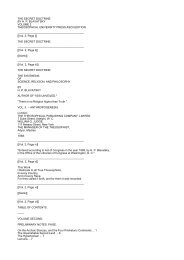Create successful ePaper yourself
Turn your PDF publications into a flip-book with our unique Google optimized e-Paper software.
The Versions Of The <strong>Book</strong> Of The <strong>Dead</strong>.<br />
6. Stromata, VI., 4, 35, ed. Dindorff, t. iii., p. 155.<br />
7. On <strong>the</strong> sacred books <strong>of</strong> <strong>the</strong> Egyptians see also Iamblichus, De Mysteriis, ed. Par<strong>the</strong>y, Berlin 1857, pp. 260, 261; Lepsius,<br />
Chronologie, p. 45 ff.; and Brugsch, Aegyptologie, p. 149.<br />
8. ###.<br />
9. ###.<br />
10. ###.]<br />
{p. xxvii}<br />
Influence <strong>of</strong> <strong>the</strong> priests <strong>of</strong> Annu on its compilation.<br />
pyramid texts are versions <strong>of</strong> ancient religious compositions which <strong>the</strong> priests <strong>of</strong> <strong>the</strong> college or school <strong>of</strong><br />
Annu[1] succeeded in establishing as <strong>the</strong> authorized version <strong>of</strong> <strong>the</strong> <strong>Book</strong> <strong>of</strong> <strong>the</strong> <strong>Dead</strong> in <strong>the</strong> first six<br />
dynasties. Ra, <strong>the</strong> local form <strong>of</strong> <strong>the</strong> Sun-god, usurps <strong>the</strong> place occupied by <strong>the</strong> more ancient form Tmu;<br />
and it would seem that when a dogma had been promulgated by <strong>the</strong> college <strong>of</strong> Annu, it was accepted by<br />
<strong>the</strong> priesthood <strong>of</strong> all <strong>the</strong> great cities throughout Egypt. The great influence <strong>of</strong> <strong>the</strong> Annu school <strong>of</strong> priests<br />
even in <strong>the</strong> time <strong>of</strong> Unas is proved by <strong>the</strong> following passage from <strong>the</strong> text in his pyramid: "O God, thy<br />
Annu is Unas; O God, thy Annu is Unas. O Ra, Annu is Unas, thy Annu is Unas, O Ra. The mo<strong>the</strong>r <strong>of</strong><br />
Unas is Annu, <strong>the</strong> fa<strong>the</strong>r <strong>of</strong> Unas is Annu; Unas himself is Annu, and was born in Annu."[2] Elsewhere<br />
we are told that Unas "cometh to <strong>the</strong> great bull which cometh forth from Annu,[3] and that he uttereth<br />
words <strong>of</strong> magical import in Annu."[4] In Annu <strong>the</strong> god Tmu produced <strong>the</strong> gods Shu and Tefnut,[5] and in<br />
Annu dwelt <strong>the</strong> great and oldest company <strong>of</strong> <strong>the</strong> gods, Tmu, Shu, Tefnut, Seb, Nut, Osiris, Isis, Set and<br />
Nephthys.[6] The abode <strong>of</strong> <strong>the</strong> blessed in heaven was called[7] Annu, and it was asserted that <strong>the</strong> souls <strong>of</strong><br />
[1 Annu, <strong>the</strong> metropolis <strong>of</strong> <strong>the</strong> thirteenth nome <strong>of</strong> Lower Egypt; see Brugsch, Dict. Géog., p. 41; de Rougé, Géographie<br />
Ancienne de la Basse-Égypte, p. 81; and Amélineau, La Géographie de Égypte a l'Époque Copte, p. 287. Annu is ###,<br />
Genesis xli., 45; ###, Genesis xli., 50; ### Ezekiel xxx., 17; and Beth Shemesh, ### 4:11 Jeremiah xliii., 13; and <strong>the</strong><br />
Heliopolis <strong>of</strong> <strong>the</strong> Greek writers (H?liou'polis, Strabo, XVII., 1., §§ 27, 28; Herodotus, II., 3; Diodorus, I., 57, 4).<br />
2. ###. Maspero, Unas, II. 591, 592; and compare Pepi I., II. 690, 691.<br />
3. See line 596.<br />
4. ###.<br />
5. ###. Maspero, Pepi I., 1. 465, 466.<br />
6. The Pyramid <strong>of</strong> Pepi II., 1. 665.<br />
7. In reading Egyptian religious texts, <strong>the</strong> existence <strong>of</strong> <strong>the</strong> heavenly Annu, which was to <strong>the</strong> Egyptians what Jerusalem was<br />
to <strong>the</strong> Jews, and what Mecca still is to <strong>the</strong> Mubammadans, must be remembered. The heavenly Annu was <strong>the</strong> capital <strong>of</strong> <strong>the</strong><br />
mythological world (see Naville, Todtenbuch (Einleitung), p. 27), and was, to <strong>the</strong> spirits <strong>of</strong> men, what <strong>the</strong> earthly Annu<br />
was to <strong>the</strong>ir bodies, i.e., <strong>the</strong> abode <strong>of</strong> <strong>the</strong> gods and <strong>the</strong> centre and source <strong>of</strong> all divine instruction. Like many o<strong>the</strong>r<br />
mythological cities, such as Abtu, Tattu, Pe, Tep, Khemennu, etc., <strong>the</strong> heavenly Annu had no geographical position.]<br />
{p. xxviii}<br />
<strong>the</strong> just were <strong>the</strong>re united to <strong>the</strong>ir spiritual or glorified bodies, and that <strong>the</strong>y lived <strong>the</strong>re face to face with<br />
<strong>the</strong> deity for all eternity.[1] judging from <strong>the</strong> fact that <strong>the</strong> texts in <strong>the</strong> tombs <strong>of</strong> Heru-hetep and Neferu,<br />
and those inscribed upon <strong>the</strong> sarcophagus <strong>of</strong> Taka, all <strong>of</strong> <strong>the</strong> XIth and XIIth dynasties, differ in extent<br />
only and not in character or contents from those <strong>of</strong> <strong>the</strong> royal pyramids <strong>of</strong> Sakkâra <strong>of</strong> <strong>the</strong> Vth and VIth<br />
http://www.sacred-texts.com/egy/ebod/ebod03.htm (15 <strong>of</strong> 36) [8/10/2001 11:22:55 AM]

















